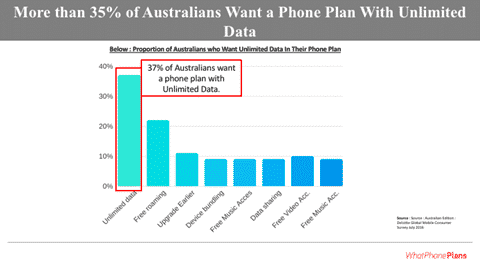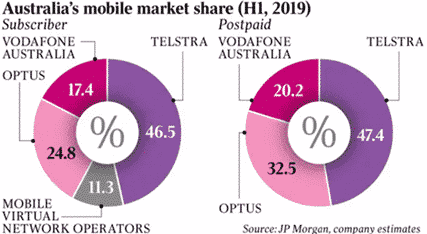Types of phone plans?
Generally speaking, a new phone plan is a paid agreement between a telecommunication provider and a consumer, which allows an individual connect to the telco’s network for calls, text messages, and access to the internet using mobile data.
These plans come in different types — prepaid plans which are generally no-contract plans that require payment before service, and postpaid plans which are generally contract plans where service is provided prior to payment at the end of a specified cycle.
The Australian telco industry
The Australian telecommunications market – for mobile services – is dominated by three major companies:
- Telstra;
- Optus; and
- Vodafone.
Telstra Australia’s largest telco, providing numerous services including home phones, mobile devices, and broadband internet. Optus ranks second amongst the nation’s telcos, offering its subscribers about 30 personal plans and 8 business plans. Vodafone is the smallest of all three companies, covering mostly metropolitan and larger regional areas.
The Australian mobile market. Source: Whatphone
These telecommunication firms provide the infrastructure, cellular coverage and bandwidth on which a lot of MVNOs (Mobile Virtual Network Operators) host their cellular services. Telstra is the host network to MVNO’s such as Woolworths Mobile and Lycamobile, whereas Optus and Vodafone cover networks including Amaysim and Think Mobile respectively. Collectively, Australian telecommunication networks cater to 16 million mobile subscribers.
What do Australians want in a phone plan?
The Australian mobile market has witnessed an evolution over the past few years. With the constant reinvention of technological devices and network services, the needs of individuals have changed. By taking a closer look at trends in mobile service use, we can determine what Australians really want in a phone plan.
- Unlimited data
Eighty-four percent of the Australian population uses smartphones. This makes Australia the fourth largest market globally after Norway (91%), South Korea (89%) and The Netherlands (87%). A large section of smartphone users are millennial – individuals born between 1981 and 1996. They account for 95% of smartphone ownership as reported by Deloitte Mobile Consumer Survey.
Considering the high smartphone penetration, Australia’s data requirements are predictably high. A record 69% of the populations are active social media users with a mobile penetration of 78%. The social usage of the Australian mobile market has witnessed the fastest growth rate – 7% year-over-year. This is reflected in the steady rise in the popularity of unlimited data plans. On the flip side, Telco’s have also experienced a rise in zero data plans.
When presented with several choices, most Australians choose unlimited data. Source: WhatphoneAccording to Nielsen, the 18% of the population who need small amounts of data (Less than 6GB) are possibly utilizing Wi-Fi to access the internet. Records have proven that individuals are connecting to Wi-Fi from their mobile devices 3.75 times more than their cellular data.
The 2016 CTIA Wireless Industry’s 20th Report shows that consumers only use an average of 3.9GB of data per month. Curiously, about 50% have unlimited data plans. It is possible that many individuals do not know how much data they really need, hence opting for unlimited plans. - Texts? No Thanks
According to trends in phone plans, consumers need less text message bundles. Smartphone users have utilized the cellular text message feature less and less in the last few years.
However, according to Pew Research Centre, texting is the most widely-used feature in smartphones. But this is likely due to the availability of numerous texting apps which utilize mobile data. These apps include WhatsApp messenger, Viber, and Facebook Messenger.
It can be assumed that many consumers are opting to buy plans with less text messaging bundles in order to save money, or that they simply view SMS as irrelevant. - Calls
A survey conducted by ReportLinker in 2017 showed that 37% of its respondents used their phones to make calls. A record 26% utilize their phones for texting, while 16% used their phones to access the internet.This survey is based on 536 online responses received between January 12th and 13th, 2017.
Although social media seems to have taken over mobile use, the ability to make calls are still an important factor for smartphone users.
From the report, there is no specification as to whether the respondents made the calls via cellular networks or over the internet. However, many phone plans include unlimited calls so many consumers do not need to bother about extra expenses on calls.
Final words
The Australian mobile market caters to an estimated 16 million subscribers. By taking a close look at the ever evolving phone use trends, we are able to determine what Australians really want in phone plans. The data demand continues to increase as consumers do more with their cell phones. From social media use to streaming music and video files, the data demand is becoming increasingly significant. Also, with the emergence of 5G coming into play soon, one can expect this increase in data demand to be even more apparent.
Sources
